#Royal Observatory
Photo

The red time ball and weather vane on top of Flamsteed House at the Royal Observatory Greenwich.
Two minutes before 13:00 it rises up the pole and then at 13:00 it drops thereby signalling the time to ships on the River Thames below. It first operated in 1833 and has been in operation every since.
#red#time ball#tmeball#observatory#royal observatory#history#time#device#Flamsteed House#13:00#clock#Greenwich#London#England#UK
119 notes
·
View notes
Text
Searching for Halley's Comet at Greenwich Observatory (1909)

This light-hearted take on astronomy's endless quest for bigger and better telescopes illustrates the growing popular interest in astronomy, particularly surrounding events such as the return of Halley’s Comet, and demonstrates that the Royal Observatory has long been intimately connected in the popular imagination with such important moments in astronomy
6 notes
·
View notes
Text

Happy Solar Eclipse Day! 🌞
Here's the first total solar eclipse photograph taken 173 years ago (28 July 1851) by Johann Julius Friedrich Berkowski, a Prussian known for his ability as a daguerreotypist, at the Royal Observatory in Königsberg, Prussia (now Kaliningrad, Russia).
This was the first occasion that an accurate photographic image of a solar eclipse was recorded.
#Total Solar Eclipse 2024#total solar eclipse#solar eclipse#Johann Julius Friedrich Berkowski#first solar eclipse photograph#Royal Observatory#Königsberg#Prussia#Koenigsberg Observatory
4 notes
·
View notes
Photo

Heather Couper was born on June 2, 1949. A British astronomer, broadcaster and science populariser, Couper was senior planetarium lecturer at the Royal Observatory, Greenwich. She subsequently hosted two series on Channel 4 television – The Planets and The Stars – as well as making many TV guest appearances. On radio, Couper presented the award-winning program Britain’s Space Race as well as the 30-part series Cosmic Quest for BBC Radio 4. Couper served as president of the British Astronomical Association from 1984 to 1986 and was Astronomy Professor in perpetuity at Gresham College, London.
#heather couper#astronomy#royal observatory#the planets#the stars#cosmic quest#women in science#women in history#science#science birthdays#science history#on this day#on this day in science history
0 notes
Text
Hour Zero: Time Starts Here
Hour Zero: Time Starts Here
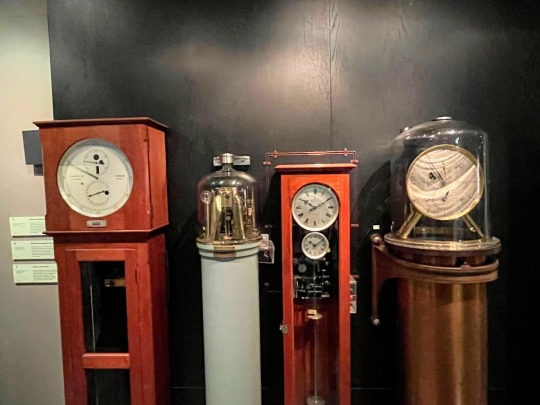
View On WordPress
0 notes
Text
DP X DC WRITING PROMPT #15
(#) = Notes at the end of post
✦
A Lonely Star Shines in the Night
The Guys in White have gone too far. So far that the Danny's universe as they know it is collapsing into itself as a result of the agent's foolish attempt to rid the land of the dead, undying, and neverborn. They tried nuking the Infinite Realms and all it got them was their dimension erased with the Infinite Realms only suffering minor damage.
Either way, Danny's home is gone.
In the struggle to gather his family and spirit them away into the Ghost Zone, he was separated from them when the GIW blew the portal to smithereens with him on the other side and his family still in the living realm. Overtaken by grief, his core cracking from his failure to protect those precious to him, he scoured the Realms for a natural portal back, to no avail.
In his search, he is nearly driven mad by his desperation. Unable to see their King in such pain and slowly unraveling into a second coming of Pariah Dark, Clockwork, Frostbite, and Pandora gather their strength and force him into an entirely different universe to grieve and heal. A universe full of heroes. He won't know this for a while, however, because where he ended up was the old Gotham observatory.
With his obsession of protecting--his friends, his family, his town, his entire world--torn to shreds, his damaged core magnified his secondary obsession: the very cosmos itself. His core latched onto the remaining obsession and inadvertently temporarily tied Danny to the very foundation of the old observatory. That is where he lingers for years, unable to leave and unable to stop crying for his lost family and friends, repeating their names over and over in a neverending mantra.
It isn't until much later that people start to notice his presence, due to the observatory having been unused for decades. What use was an observatory if you couldn't even see the stars in the perpetual smog that blanketed the city? At some point, however, a couple of daring teenagers snuck into the observatory one night and had a first hand encounter with a strange being. Needless to say, they didn't stick around for much longer. The reports they made to the police and what they posted on social media the next day were nonetheless wildly interesting.
Each of them described relatively the same thing. Of first seeing a bright, sliver star shining in the dark(1) of the empty building but then quickly noticing it was set in the center of the chest of a being that might as well have been made from the black void of the night sky itself. They described a being with hair that faded into white, glowing mist that was circled by a crown of ice crystals and star dust. Most notable of all to them, however, were the low humming whispers coupled with the mercury tears leaking from aurora green eyes in a neverending stream that dripped and echoed hauntingly across the marble floors below.
Of course, no one really believed their wild tales at first. Then it became a game among high schoolers and college students to wander the old observatory just to see if they would catch sight of this mysterious being. If not, no harm done. That is until one student accidentally injured themselves trying to find this ghost they've been hearing rumors about. (2)
Regardless of whether or not the being inhabiting the observatory directly caused this student's injury, he's gained the Batclan's attention.
✦
Notes:
(1) The star in his chest is his core. The black/night parts of his ghost form are slightly translucent even when not intangible/invisible. You can literally see straight through him to his core, which basically looks like a condensed white dwarf star. Also, due to the damage his core has taken and his grief, it's cracking and looks like it's going to go supernova.
(2) Danny didn't directly cause the student to get injured. The student literally just turned the corner and nearly ran right into Danny as he was wandering in his grief-stricken stupor. This caused the student to freak out, run the opposite direction, and fall down a flight of stairs cause they weren't watching where they placed their feet. Danny is not violent or territorial here. His mind has literally checked out and left because trauma, grief, and a fractured sense of ghostly self are one hell of a combo on a halfa.
#dp x dc#dc x dp#danny is stuck/forced to haunt the old Gotham observatory after the GIW royally screw up#danny gets pushed into another dimension to heal/deal with his grief around people who can help him#the batclan get invested and extremely worried for danny almost immediately upon meeting him#danny has two obsessions#protection and space#danny is ghost king#ghost core#his core looks like a white dwarf star#it also looks like its on the brink of going supernova#if someone doesn't help him soon thats exactly what will happen and he'll basically cease to exist#dp crossover#danny phantom crossover#dp x dc crossover#dp x dc prompt#writing prompt#prompt#sleepy-writes-stuff
718 notes
·
View notes
Text

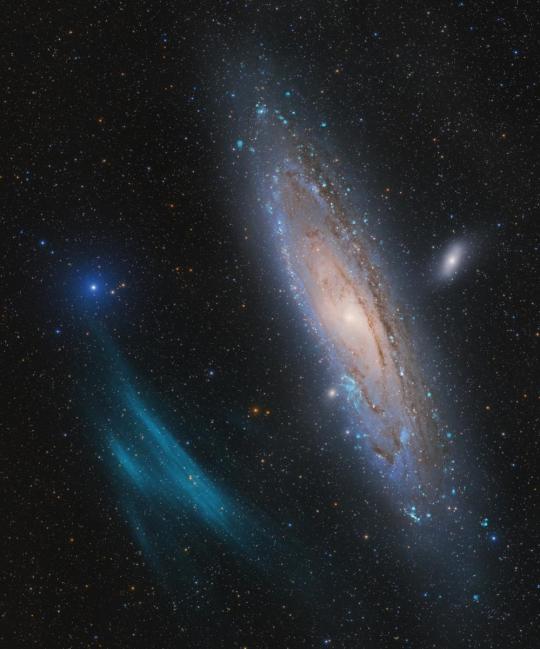
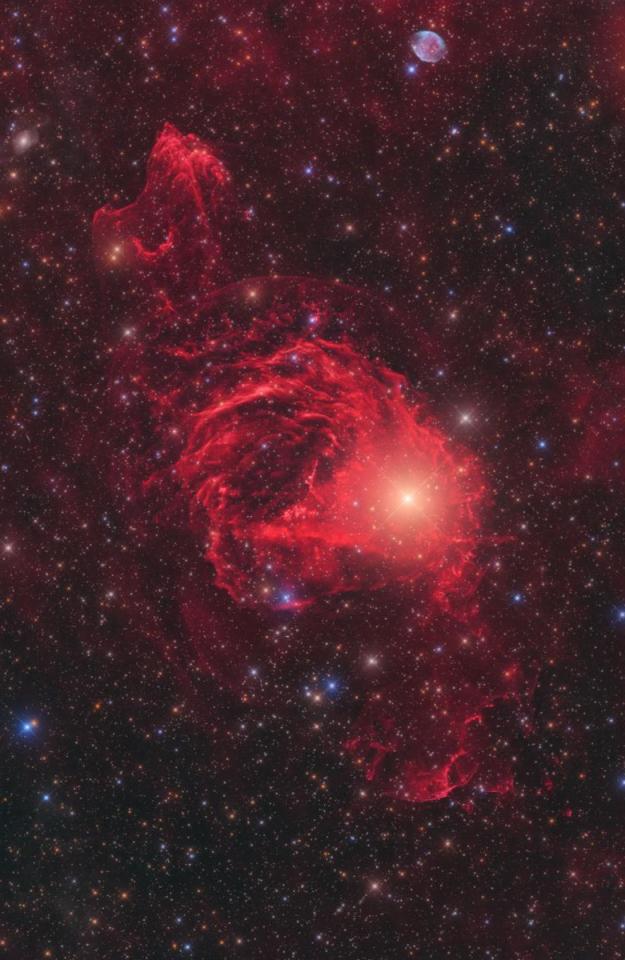



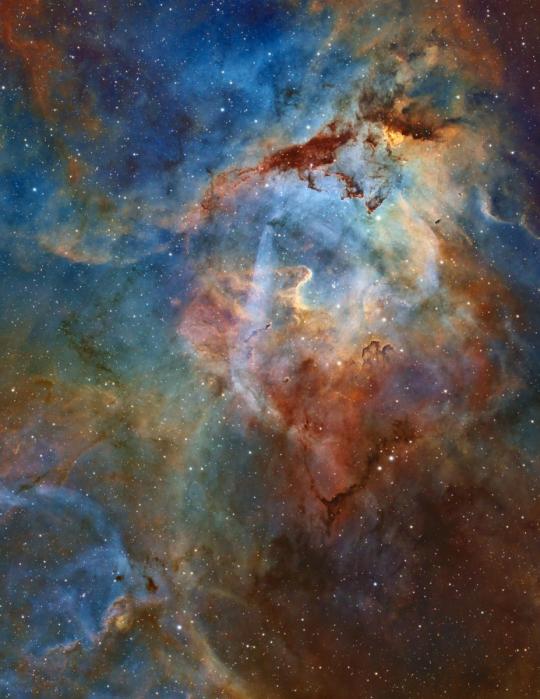


Astronomy Photographer of the Year Award 2023
Brushstroke by Monika Deviat
Andromeda, Unexpected by Marcel Drechsler, Xavier Strottner and Yann Sainty
New Class of Galactic Nebulae Around the Star YY Hya by Marcel Drechsler
Suspended in a Sunbeam by Tom Williams
A Sun Question by Eduardo Schaberger Poupeau
Mars-Set by Ethan Chappel
Sh2-132: Blinded by the Light by Aaron Wilhelm
Grand Cosmic Fireworks by Angel An
The Running Chicken Nebula by Runwei Xu and Binyu Wang
#i literally cried at work while looking at these#like???#the universe is so incredibly gorgeous i can't believe it's real and we are able to look at photographs of it#Astronomy Photographer of the Year Award 2023#apy15#space exploration#Royal Observatory Greenwich#andromeda galaxy#astrophotography#aurora#how are these real#the one of the sun looks so fluffy#running chicken nebula#what a name#space#<3#beauty#art#humanity
10 notes
·
View notes
Photo




...the Great Equatorial Telescope, the UK’s biggest refracting telescope. You can tell from the people around it that it’s a pretty formidable piece of kit. It’s no longer used for serious astronomical research - too much light pollution from London, I assume - but the Observatory does hold public viewing sessions where you can book to come and have a go on it.
I think that’ll do for tonight, so the last lot of photos - from the British Museum today - will have to wait until tomorrow evening.
9 notes
·
View notes
Text
你的明星梦,我的作家老师梦。
比起你的梦:光鲜,靓丽,钱财,社会地位,可以几个月内拔地而起。
而我的梦:多年的知识积累,智慧,技能的累积,可能就只是出个书,没什么一夜的暴富几率。比起做生意,当个作家,老师,还要以身作则,频频教诲,孜孜不倦,十年树木,百年树人。简练的想法,简练的言辞,可以轻而易举的被认为太简单了,我也能想得到。重点在于,第一个想到的就是研发,而后起的可能就模仿。
对于支持的尊重和保护,中西有着本质的差别,一个有研发技能的工程师的待遇,在西方国家就是高级重点重金属,而在亚洲,待遇截然不同。
大家可能觉得偶然,纯是运气之来。偶然在某个时间段,时间点上就很有可能是必然。
我们对于时间空间转换不同世界,不同历史都有很多电影想象。
而我的观点是,偶然很可能就是必然,在那个特定的时间点,事情发生点,人物,地点,特定环境下,所有的参数全部加起来集中的一点历史,就可以推断必然是概率是极大的。
希望所有有知…

View On WordPress
0 notes
Text
0 notes
Text
Scientists May Have Unraveled a Long-Standing Mystery About the Sun
— By Aristos Georgiou | August 24, 2023

Illustration of the ESA/NASA Solar Orbiter spacecraft observing the sun. The spacecraft has discovered numerous tiny jets of material escaping from the sun’s atmosphere that could be the source of the solar wind. ESA
Scientists have uncovered the mysterious source of a key solar phenomenon that has long-puzzled experts.
The Solar Orbiter spacecraft, developed by the European Space Agency (ESA) with contribution from NASA, discovered numerous tiny jets of material escaping from the sun's atmosphere.
Each of the tiny jets lasts between 20-100 seconds and expels plasma—a stage of matter consisting of superheated, charged particles—at a speed of around 224,000 miles per hour. The jets could be a long-sought-after source of the solar wind, according to a study published in the journal Science.
Our sun's outer atmosphere, or corona, constantly spews out a stream of plasma, known as the solar wind, that can reach speeds of more than 1 million miles per hour. This stream, which contains embedded solar magnetic field, expands throughout the entire solar system reaching far beyond the orbit of Pluto before it meets the interstellar medium.
The solar wind and magnetic field inflate a vast "bubble" in the surrounding interstellar material, which is known as the heliosphere.
Variations in the solar wind can produce several space weather phenomena that affect Earth. For example, under certain circumstances, it can interact with the Earth's magnetic field in a way that produces auroras.
Meanwhile, particularly high-speed streams of solar wind can result in geomagnetic storms that have the potential to disrupt navigation systems and produce harmful currents in power grids and pipelines, among other impacts.
"Understanding the solar wind is a key prerequisite for understanding space weather. Results like these are steps towards understanding the dynamic nature of the solar wind," ESA solar physicist Daniel Müller told Newsweek.
The solar wind is a fundamental feature of the sun but understanding exactly how and where it is generated has proven elusive, even though scientists have been studying the question for decades.
But the advanced instrumentation on the Solar Orbiter, considered the most complex scientific laboratory ever sent to study our star, has now shed new light on what drives the generation of the solar wind.
For the latest study, scientists examined data collected by the Solar Orbiter's Extreme Ultraviolet Imager (EUI) instrument.
In March 2022, this instrument took images of the sun's south pole, which researchers then analyzed. This revealed numerous short-lived and tiny jets, each one expelling plasma into space.
"We could only detect these tiny jets because of the unprecedented high-resolution, high-cadence images produced by EUI," Lakshmi Pradeep Chitta with the Max Planck Institute for Solar System Research, Germany, and the principal author on the paper, said in a press release.
The tiny jets that the researchers observed could be seen emanating from a structure on the sun known as a coronal hole. These vast holes are regions where the sun's magnetic field does not turn back down into the star. Instead, the magnetic field stretches out deep into the solar system.
It's been known for decades that some of the solar wind that the sun produces is generated in these regions. (Coronal holes which are most prevalent and stable at the sun's north and south poles, produce solar wind of relatively high speed. The solar wind that emanates from the equatorial regions of the sun, where there are fewer coronal holes, on the other hand, tends to be slower in speed).
But while scientists knew that high-speed solar wind originated from coronal holes, how exactly the plasma was launched remained something of a mystery. Now, the latest findings suggest that the tiny jets may be responsible for launching the plasma that feeds the solar wind as they travel away from the sun.
The study also challenges previous assumptions that the high-speed solar wind from coronal holes emerges in flows that are relatively steady. The researchers found that to a large extent, this flow is not actually uniform but is instead highly intermittent.
"This paper shows that also the fast solar wind is much more dynamic than originally thought," Müller told Newsweek.
The jets that the team discovered produce relatively little energy in the grand scheme of solar activity. For context, the most powerful corona phenomena, known as X-class solar flares, produce around a billion times more energy than so-called nanoflares. But the tiny jets are even a thousand times less energetic than these nanoflares.
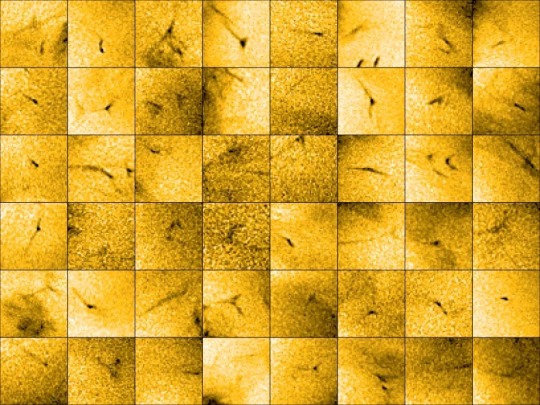
Images from the ESA/NASA Solar Orbiter spacecraft show tiny jets of material escaping from the sun’s outer atmosphere. The jets show up as dark streaks across the solar surface in this mosaic. EUI TEAM/SOLAR ORBITER/ESA & NASA
The fact that the scientists saw so many of the tiny jets in the recent observations indicates that they are expelling a substantial fraction of the material that can be found in the solar wind.
"I think it's a significant step to find something on the disc that certainly is contributing to the solar wind," David Berghmans, principal investigator for the EUI instrument with the Royal Observatory of Belgium, said in the press release.
But it is possible that there could be other even smaller and more frequent events that could be contributing further.
Future research will be able to shed light on this issue. Currently, the Solar Orbiter is circling the sun close to the star's equator. This means that the tiny jets at the South Pole could only be seen edge-on, making it harder to measure some of their properties.
But as the Solar Orbiter mission continues, it will gradually incline its orbit toward the uncharted polar regions
"In a few years, we will see them from a different perspective than any other telescopes or observatories so that together should help a lot," Müller said in the press release.
The latest findings, alongside other observations being made by the Solar Orbiter, have implications for our understanding of space weather, according to Müller.
'With the Solar Orbiter mission, which is also sampling the solar wind at the location of the spacecraft, we can measure the variability of the solar wind at different distances between the sun and Earth," he told Newsweek. "This will help scientists build better computer models to forecast the solar wind and space weather conditions near Earth based on solar observations."
#Scientists#Sun | Mystery#European Space Agency (ESA) | NASA#Superheated | Charged Particles#Solar Wind#Journal Science#Solar Magnetic Field#Earth | Pluto | Bubble | Heliosphere#Earth's Magnetic Field | Auroras#ESA Solar Physicist Daniel Müller#Lakshmi Pradeep Chitta | Max Planck | Institute For Solar System Research | Germany 🇩🇪#Solar Orbiter's Extreme Ultraviolet Imager (EUI)#Coronal Hole#Intermittent#Plasma#Tiny Jets#EUI TEAM/SOLAR ORBITER/ESA & NASA#Royal Observatory | Belgium 🇧🇪#Solar Orbiter | Equator#Computer Models
1 note
·
View note
Photo

Night time Greenwich
The Queen’s House and the Old Royal Naval College with the Royal Observatory in the background
#Queen's House#Old Royal Naval College#history#royal observatory#night photography#colour#color#Greenwich#London#England#UK
72 notes
·
View notes
Text
Maria Mitchell In Her Own Words

Jan. 11th {1858}. . . . All the early observatories of Europe seem to have been built as temples to Urania, and not as working chamber of science. The Royal Observatory of Greenwich, and the Imperial Observatory of Paris, and the beautiful structure in Calton Hill, Edinburgh, were, at first, wholly useless as Observatories. That of Greenwich had no steadiness, while every pillar in the astronomical temple of Edinburgh, though it may tell of the enlightenment of Greece, hides the light of the stars from the Scottish observer. Well might Struve say that “an observatory should be a simple box to hold instruments.”
Ironically, Maria’s thoughts above would come true for her – the Vassar College Observatory was not built or equipped in the way she would have liked though it was begun before she had agreed to become its director and the professor of astronomy at Vassar. But its important to recognize that sometimes someone can be so caught up in the appearance of something and leaving her or his mark that they don’t take into account how something is really going to be utilized and by whom. So it appears that when built, according to Maria, that these sites were built to be “temples” and to stand out for their beauty, not to stand out for the activity that would happen inside them – and not to be designed with that activity in mind. That is why you need a diverse group to make sure a site is created that is usable – for all.
JNLF
#Nantucket#Maria Mitchell#Nantucket Maria Mitchell Association#Royal Observatory Greenwich#Imperial Observatory of Paris
0 notes
Text
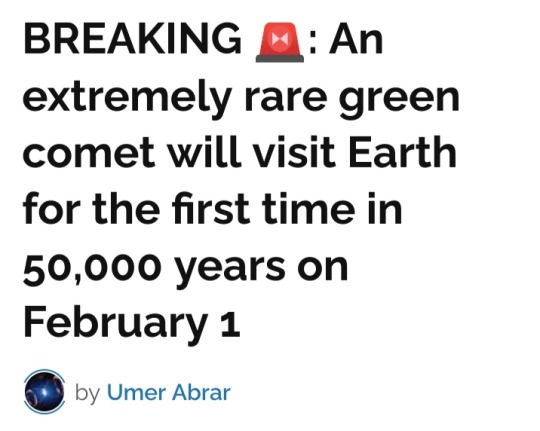
20 January 2023
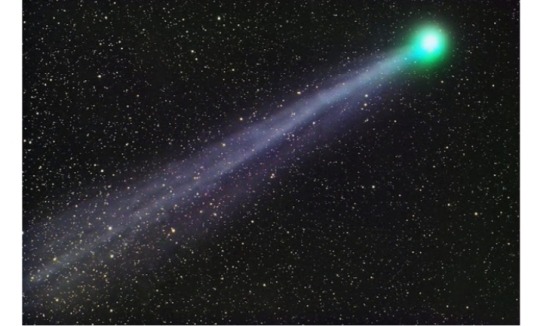
Despite the fact that 2023 has only started, the cosmos are already poised to create history.
A comet that was just recently identified will be visible in a few weeks during what is likely to be its one and only documented appearance.
The comet is expected to have traveled billions of kilometers from its thought beginnings near the fringe of our solar system.
In March 2022, the comet C/2022 E3 (ZTF) was initially seen when it passed through Jupiter's orbit.
It's a long-period comet that NASA believes originated in the Oort Cloud, the furthest area of the solar system, which is described as "like a gigantic, thick-walled bubble formed of frozen chunks of space debris" and may grow to be even larger than mountains.
According to estimates, the inner boundary of this zone is located between 2,000 and 5,000 astronomical units (AUs), or 186 billion and 465 billion miles, from the sun.
This indicates that C/2022 E3 (ZTF) has traveled on a unique, exceptional voyage to be near Earth.

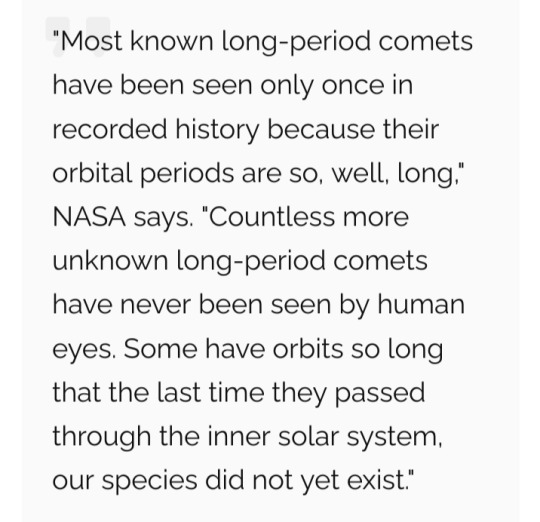
C/2013 A1 Siding Spring, a recent comet of this sort, already visited the inner solar system and passed close to Mars in 2014.
However, the space agency estimates that it won't return for around 740,000 years.
According to Jessica Lee, an astronomer from the Royal Observatory Greenwich, the E3 comet may provide a similar scenario.
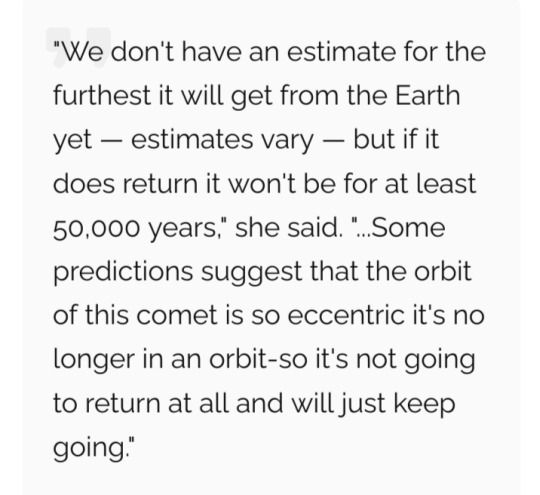
The freshly found E3 comet will now reach its closest approach to the sun on January 12.
It has been seen to have a vivid greenish coma and "short wide" dust tail.
On February 2, it will get as near to Earth as it will.

According to NASA, the comet will be seen with binoculars if everything goes according to plan and its brightness trend continues.
Away from city lights, it could also be seen with the unaided eye. According to NASA, the comet will be visible in the morning hours of January in the northern hemisphere and in the early morning hours of February in the southern hemisphere.
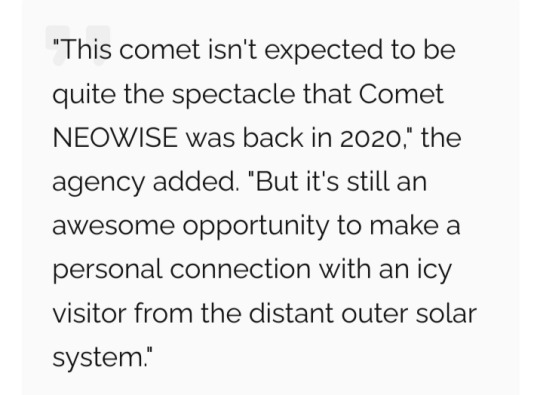

#C/2022 E3 (ZTF)#comet#Oort Cloud#long-period comet#C/2013 A1 Siding Spring#Royal Observatory Greenwich#E3 comet#NASA#astronomy#space
1 note
·
View note
Text
happy 10th anniversary to the first time I ever felt the compulsive need to remember the date
#i was 12 and i went to the royal observatory and saw jupiter's moons through a telescope and also bought my own mini telescope :]#and also had that weird throat closing up thing that i get a lot more frequently now than i did back then rip#but i have officially been hoarding my memories for 10 obsessive compulsive years <3#but anyway More Importantly#happy 10 year anniversary to entre telling swag he's part of his dream fuCK OFF FUCK OF CUX DOFNWJD DDJ I am so ill about then sis ejdb#ramble
0 notes
Text
I’ve always kind of known that the concept of daylight savings was BS once the whole we-need-more-daylight-to-produce-food-for-soldiers-in-the-Great-War thing was over, but somehow I never realized that even among the countries that do observe daylight savings, fall back/spring forward don’t happen at the same time worldwide.
I’m traveling in the UK and we had fall back last weekend, about which I thought “huh, I don’t remember this happening so close to Halloween before, silly me and my silly memory,” only to come on to Tumblr. Com this weekend to see my dash filled with Cousin Oskar and complaints about the time change and realize we can’t even be bothered to organize one collective alteration to the social construct that is time.
Oh no, we must be spitefully and chaotically individualistic, mustn’t we.
#the Royal observatory in Greenwich really said ‘we are the arbitrary center of space and time’#and then every other country and a couple of random us states decided to cause as many problems as they could#without actively wreaking havoc on international functionality#first person
1 note
·
View note